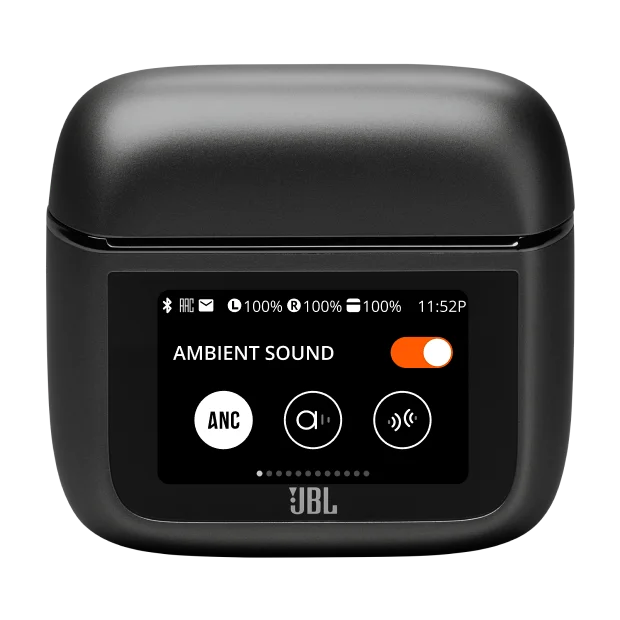For the better part of the past five years, wireless earbuds have been my go-to audio listening device. The discretion, portability, and the componentry nature of two nimble earbuds over one (relatively) hulking set of headphones have been my main reasons for using them, albeit at a cost: earbuds usually don’t sound amazing compared to headphones in the same price range. The open ear, lightweight nature of earbuds had forced me to sacrifice technical features and the ability to physically block out ambient noises for portability, but that gap had been closing rapidly over the last few years.
The JBL Tour Pro 3 exemplifies the advancements made in wireless earbud technology and the ability for audio brands to stuff more technology into them. But after using the earbuds for a fortnight, I started to question: Does putting more technology into an audio device inherently make said device better? The answer is yes, but not always.
While the technology that JBL put into the earbuds of the Tour Pro 3 is impressive: better drivers, ability to set spatial sound, a top-notch ANC (active noise cancellation), it was let down by the smart charging case and the tech that went into it. The result is a fantastic set of earbuds that can cater to multiple ear sizes, feels great, and generates audio with great fidelity. It is unfortunately held back by the case that houses the earbuds: a slightly overweight, bulky case whose main feature (the touchscreen) is an unnecessary and laggy experience.

From the get-go, the JBL Tour Pro 3 arrives packed with options in mind: Multiple (and I mean MULTIPLE) sets of rubber and foam tips for different ear sizes surround the unit in the packaging, along with USB cable, and 3.5mm auxiliary cable, and literature. The first thing I noticed was the myriad of sizes of tips available: up to five sizes were housed next to the case, ranging from XS to XL, including a set of foam-lined tips that contours to your ear canals packed in a separate bag. The second thing I noticed was how gargantuan the case is: Coming in at 55 x 60 x 26mm, the Tour Pro 3 case dwarfs my current earbuds case. There’s good reason for that too; the 1.57” touchscreen is a prominent feature of the case, allowing users a plethora of options to control and customise their earbuds. Furthermore, it provides an additional 33 hours of battery life for the earbuds, which explains the 83g weight of the case – and it certainly feels hefty. A rubber backing on the case helps prevent the case sliding and minimise scratching, which is a great touch. While the case looks great and is thoughtfully designed, it feels really bulky compared to other earbud cases, and as I’ll explain later, lets the whole product down functionally.

Moving onto the earbuds themselves, JBL have really packed in a lot of technology for what seems to be their top of the line earbuds: a 10.2mm cellulose driver combined with a balanced armature driver allows high notes and bass notes to be channeled to the appropriate drivers, resulting in very clean audio that pushes out highs and lows without them impeding each other. In addition, multiple codec support and multiple mics (using AI algorithm) provide high-resolution audio and minimal disturbance from outside sources.
Hardware aside, the software hones the earbuds into a pure listening experience: Through the JBL Headphones app (or the case), you can fine-tune other aspects of the earbuds – spatial sound, personal sound customisation & testing, ANC levels, and scores of other options available to customise the earbuds to your needs.

If all that seems a bit much, I can sum all that up for you with this: The JBL Tour Pro 3 earbuds are packed with so much tech that they are easily the best sounding earbuds I’ve ever worn. They block out so much noise that I can be in the middle of a noisy office, pop these earbuds in, and feel like I’m in a soundproof chamber. Any audio coming through these sound so much clearer than any other earbuds I’ve worn, and it easily mimics the sound quality you would get from a set of studio quality over-the-head headphones. The earbuds are easily controlled by gestures on the touch sensitive surface of the earbud, and the touch options can be tailored to your needs. I found the touch controls perfect and have had no problems with quickly tapping the side of the stem to play/pause, cycling between ANC options, or controlling my music. The only (minor) gripe is that the ANC level, when turned to max, was at a frequency that gave me discomfort as if my ears were constantly popping, but that was quickly rectified the moment I turned the ANC level down one, while still being effective at noise cancelling.

Despite reading through many complaints about the fit (which seemed to be a consistent sore point amongst many people), I had absolutely no problems with it. Changing to the medium sized tips gave me a nicely sealed fit without feeling like they will fall out of my ears due to their size. I’ve been on many runs with the earbuds on, and only once did it fall out of my ear, and that was due to my hand knocking it out while wiping sweat.
One of the selling points of the JBL Tour Pro 3 that the audio manufacturer touts is the case with the touchscreen – a 1.57” touchscreen on the case that is bigger than its predecessors and designed to allow you to interact and control without having to get your phone out as much. Essentially, other than minor customisation options and tweaks to the audio, you can do just about everything on the case – even using it as a flashlight. Adding an extra 33 hours of backup juice to the earbuds, and the case seems to be a viable replacement over your phone for listening to music… on paper.

In practice, this was not the case (no pun intended): Because of the bulky nature of the case, I had never kept it in my pocket, instead opting to keep it secure in the pocket of my bag or left on a table due to the size and weight of this thing – it just felt too bulky to be handy but not feature-rich enough to free up the pocket real estate that my phone would otherwise occupy.
My biggest issue with the case (and thus with the earbuds overall) is the display: 1.57” is nowhere near big enough to be fully featured, but it would have been acceptable if it was responsive. The JBL Tour Pro 3’s smart charging case, however, is anything but: cycling between the options takes multiple attempts due to the touchscreen’s poor sensitivity, and while it is fully featured, the customisation options within said options are minimal, requiring you to open the JBL Headphones app on your phone anyway. Other features are hit-and-miss: while the Find My Buds is very handy, putting a torch option in the case by default is questionable, as the light is so meagre that it serves more as a distraction rather than a light source. Within a week of trialling the case, I turned as many features as I could off in an (unsuccessful) effort to increase sensitivity, but alas, to no avail.
Finally, the sticker price: at $429.00 (listed on the JBL website), the JBL Tour Pro 3 is PRICEY. At this price point, JBL is competing with a slew of other brands’ top of the line earbuds, and personally, I think JBL could have benefitted from adding tactile controls to the case (for a better performing screen on the case) or removing the screen altogether (to reduce the weight and cost). In an alternate reality, JBL removing the screen on this case and thus reducing the sell price of the Tour Pro 3 would have resulted in a higher score from me.

I really like the JBL Tour Pro 3 earbuds; I really do. They fit really well to my ears, sound great, have the best ANC tech I’ve experienced so far, and the touch controls on the stem are really easy to use. If only they took the same thought-out approach to the earbuds and applied it to the case, then the case may not be a bulky, unintuitive accessory to the earbuds that serves as an over-engineered charging case/paperweight but a practical and useful addition to the earbuds. In the case of the JBL Tour Pro 3, sometimes putting more features into a particular device (in this instance, the case specifically) means a lesser product overall.
Sometimes, more is less

